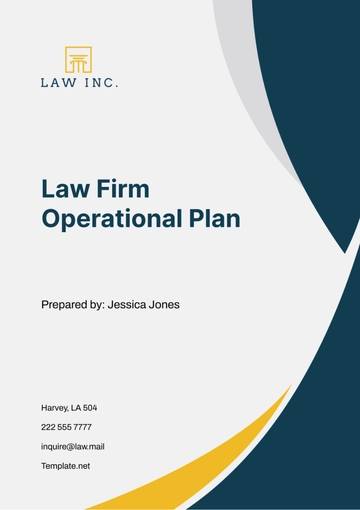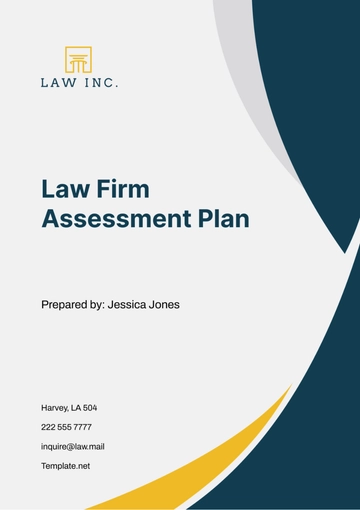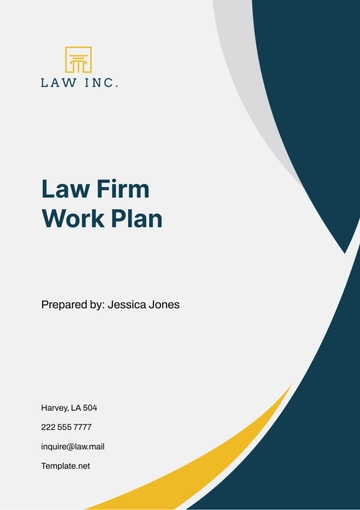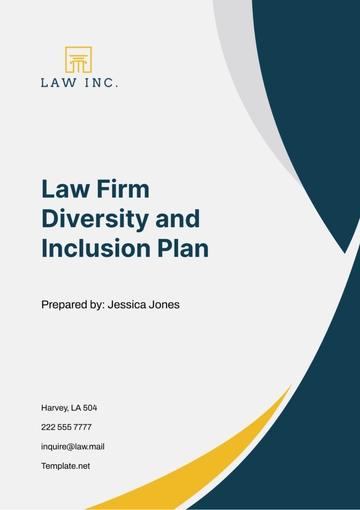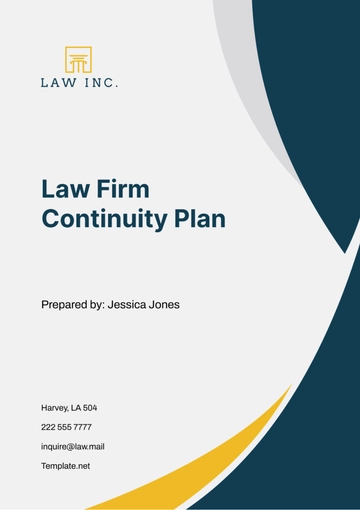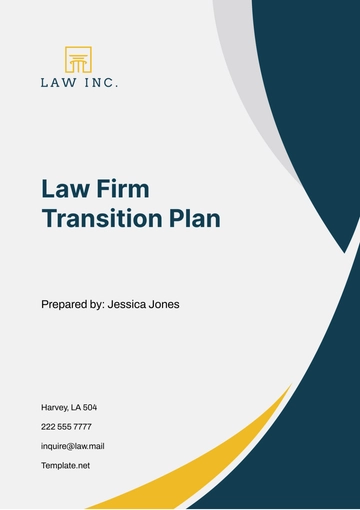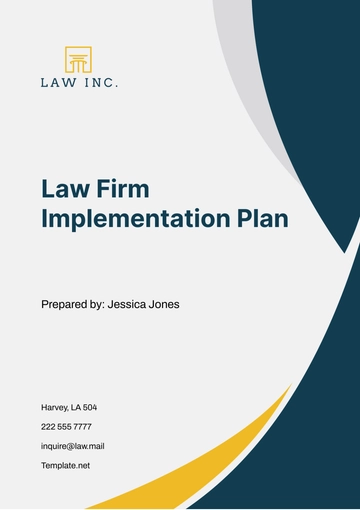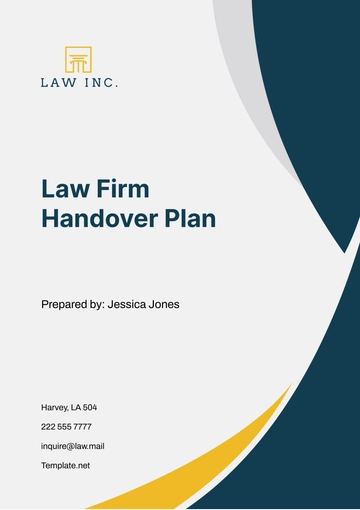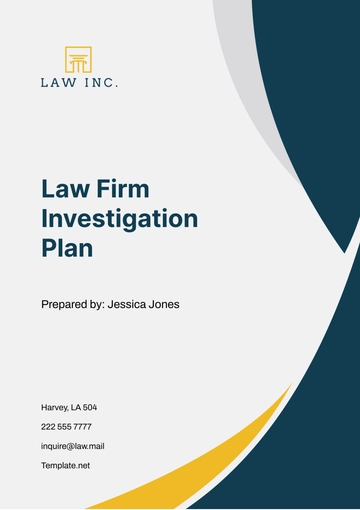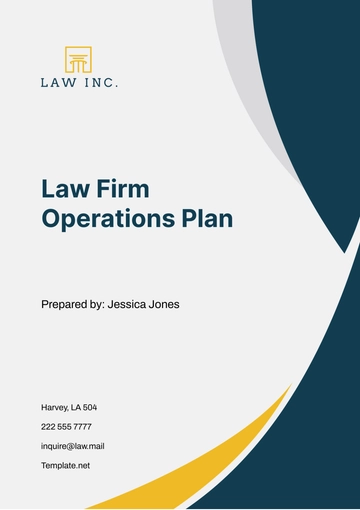Free Law Firm Continuity Plan
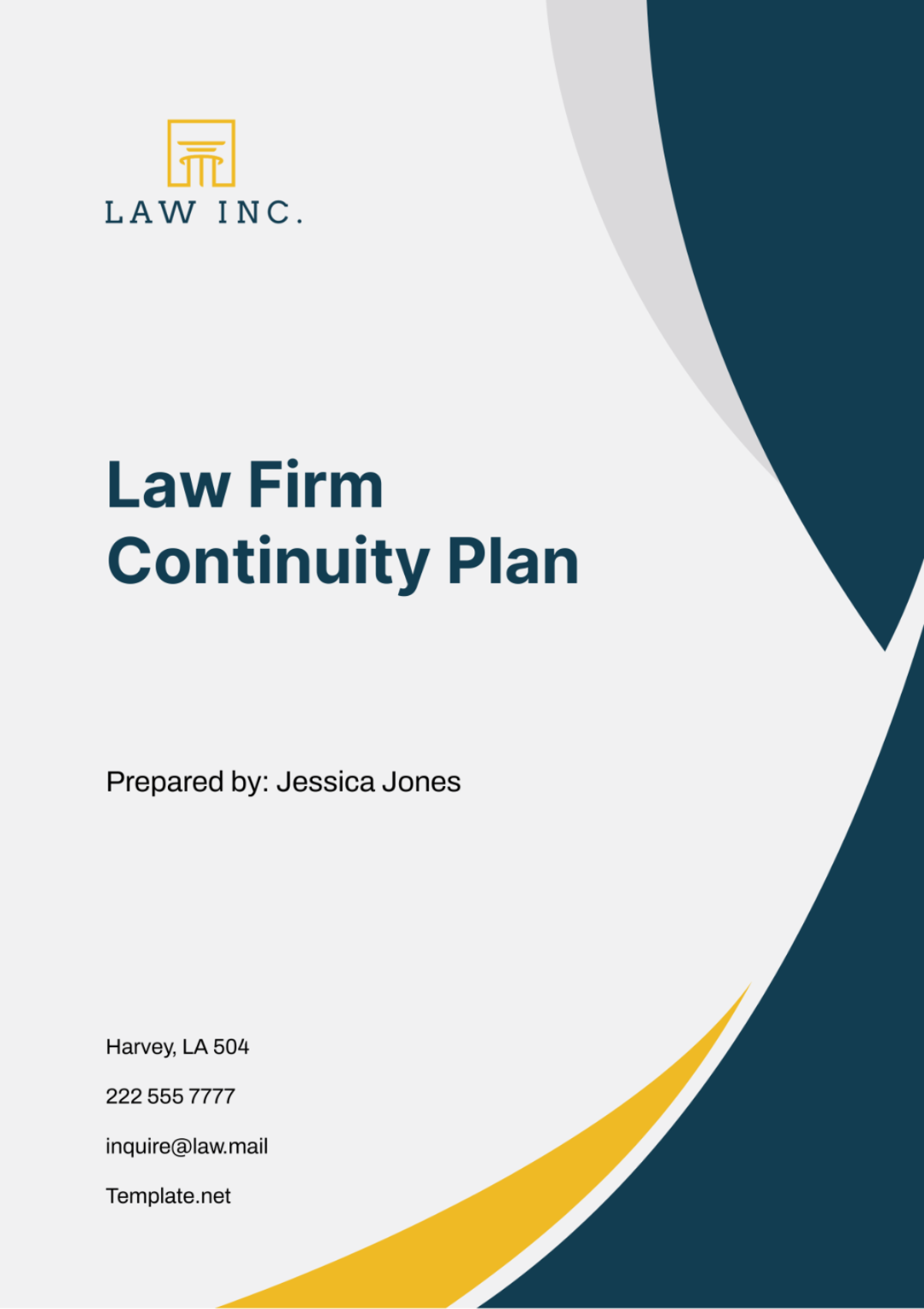
I. Introduction
At [Your Company Name], our commitment to providing exceptional legal services extends beyond routine operations to ensuring continuity of service even in the face of unexpected disruptions or emergencies. This Continuity Plan outlines our strategies and procedures for maintaining operational resilience and minimizing the impact of unforeseen events on our clients, employees, and stakeholders.
II. Risk Assessment and Business Impact Analysis
The table below provides a structured overview of the potential threats, vulnerabilities identified, impact on operations, and priority for mitigation efforts, allowing us to allocate resources effectively and prioritize risk management initiatives.
Potential Threats | Vulnerabilities Identified | Impact on Operations | Priority for Mitigation |
|---|---|---|---|
Natural Disasters (e.g., floods, earthquakes) | Office location in flood-prone area, lack of earthquake-resistant infrastructure | Office closure, damage to property and equipment | High |
Cybersecurity Breaches | Outdated software, insufficient data encryption, lack of employee cybersecurity training | Data breaches, loss of client trust, legal liabilities | High |
Pandemics (e.g., COVID-19) | Dependency on physical office space, lack of remote work infrastructure | Office closures, disruption of in-person meetings and court proceedings | High |
Technological Failures | Aging IT infrastructure, reliance on third-party vendors | Downtime, loss of access to critical systems and data | Medium |
Human Error | Lack of employee training, inadequate oversight of sensitive information | Data loss, compliance violations, reputational damage | Medium |
Supply Chain Disruptions | Dependency on single-source vendors, lack of backup suppliers | Delayed delivery of essential goods and services | Medium |
Legal and Regulatory Changes | Inadequate monitoring of legislative developments, lack of compliance resources | Non-compliance penalties, legal disputes | Low |
Natural Disasters: This category poses a high risk due to the potential for significant impact on our operations, including office closures and damage to property and equipment. The vulnerabilities identified, such as office locations in flood-prone areas and lack of earthquake-resistant infrastructure, highlight the need for proactive mitigation measures, such as relocating offices or implementing structural improvements.
Cybersecurity Breaches: With the increasing frequency and sophistication of cyber threats, cybersecurity breaches present a high risk to our firm. Vulnerabilities such as outdated software and insufficient data encryption underscore the importance of investing in robust cybersecurity measures, including regular software updates, encryption protocols, and comprehensive employee training programs to mitigate the risk of data breaches and protect client confidentiality.
Pandemics: The COVID-19 pandemic highlighted the vulnerability of our firm to pandemics and other public health emergencies. The lack of remote work infrastructure and dependency on physical office space contribute to the high risk of disruption to our operations. To address this risk, we must invest in remote work technology, establish flexible work policies, and enhance communication channels to ensure business continuity during future pandemics or similar crises.
Technological Failures: While technological failures pose a medium risk to our firm, they can still have significant implications for our operations, including downtime and loss of access to critical systems and data. To mitigate this risk, we need to invest in upgrading our IT infrastructure, implement redundancy measures, and establish proactive monitoring and maintenance protocols to minimize the impact of technological failures on our operations.
Human Error: Human error presents a medium risk to our firm, particularly in terms of data loss, compliance violations, and reputational damage. Addressing this risk requires investing in comprehensive employee training programs, establishing clear protocols and procedures, and implementing robust oversight mechanisms to minimize the occurrence of human errors and mitigate their impact on our operations.
Supply Chain Disruptions: While supply chain disruptions pose a medium risk to our firm, they can still result in delayed delivery of essential goods and services, impacting our ability to serve clients effectively. To mitigate this risk, we need to diversify our supplier base, establish relationships with alternative vendors, and implement contingency plans to ensure continuity of essential services in the event of supply chain disruptions.
Legal and Regulatory Changes: While legal and regulatory changes pose a low risk to our firm compared to other threats, non-compliance penalties and legal disputes can still have significant financial and reputational implications. To address this risk, we need to enhance our monitoring of legislative developments, allocate resources for compliance efforts, and engage legal counsel to ensure ongoing compliance with relevant laws and regulations.
III. Emergency Response Procedures
At [Your Company Name], the safety and well-being of our employees and clients are our top priorities. In the event of an emergency, we have established clear protocols and procedures to ensure a prompt and coordinated response. The following outlines our Emergency Response Procedures:
Immediate Response Protocols:
Safety First: The safety of our employees and clients is paramount. In the event of an emergency, all employees are instructed to prioritize their safety and evacuate the premises if necessary.
Emergency Contacts: Emergency contact information, including local authorities, medical facilities, and designated firm representatives, is readily accessible to all employees.
Evacuation Procedures: Clear evacuation routes and assembly points are posted throughout our offices. Employees are trained to evacuate calmly and follow designated evacuation routes to ensure everyone safely exits the building.
Business Continuity Team:
Activation: In the event of an emergency, the Business Continuity Team is activated to coordinate response efforts and ensure continuity of essential functions.
Roles and Responsibilities: Each member of the Business Continuity Team has assigned roles and responsibilities, including assessing the situation, communicating with employees and clients, and implementing response measures.
Communication Channels: The Business Continuity Team maintains open communication channels with all employees, clients, and stakeholders throughout the emergency response process.
Communication Protocols:
Internal Communication: Regular updates and instructions are communicated to all employees through various channels, including email, text alerts, and internal communication platforms.
Client Communication: Dedicated communication channels are established to provide clients with timely updates on our operational status, alternative means of contact, and any impact on ongoing legal matters.
Remote Work and Telecommuting:
Transition to Remote Work: In the event of office closures or disruptions, employees are equipped to transition to remote work seamlessly. Remote work policies and procedures ensure continued productivity and client service.
Technology Support: IT support staff are available to assist employees with remote access, troubleshoot technical issues, and ensure the security of remote work environments.
Resource Allocation:
Emergency Supplies: Emergency supply kits are stocked with essential items such as first aid supplies, flashlights, and emergency food and water.
Financial Resources: Financial reserves are allocated to support emergency response efforts, including recovery and rebuilding efforts if necessary.
Post-Emergency Recovery:
Assessment: Following the resolution of the emergency, a comprehensive assessment is conducted to evaluate the impact on our operations, employees, clients, and stakeholders.
Lessons Learned: Lessons learned from the emergency response are documented and used to refine and improve our Emergency Response Procedures for future incidents.
Recovery Measures: Recovery measures are implemented to restore normal operations, support affected employees, and address any lingering issues resulting from the emergency.
IV. Data Backup and Recovery
Regular Data Backup: Critical data and documents are regularly backed up to secure servers and cloud-based storage solutions. Automated backup processes ensure that important information is preserved and accessible even in the event of system failures or data loss.
Data Recovery Procedures: In the event of data loss or corruption, we have established procedures for prompt data recovery to minimize disruption to our operations. Regular testing of data recovery systems ensures their effectiveness and reliability.
V. Regulatory Compliance
[Your Company Name] demonstrates our commitment to upholding the highest standards of legal professionalism, ethical conduct, and regulatory compliance in all aspects of our practice by adhering to these regulatory compliance measures:
Data Protection Laws: [Your Company Name] complies with all applicable data protection laws and regulations, including but not limited to the General Data Protection Regulation (GDPR), California Consumer Privacy Act (CCPA), and other relevant regional data protection laws. We are committed to safeguarding the privacy and confidentiality of client information and maintaining compliance with data protection requirements.
Professional Ethics Rules: Our attorneys adhere to the highest standards of professional ethics and conduct as outlined by relevant regulatory bodies, such as state bar associations and legal professional organizations. We uphold principles of integrity, confidentiality, and client confidentiality in all aspects of our practice.
Conflicts of Interest Policies: [Your Company Name] has established comprehensive conflicts of interest policies and procedures to identify, prevent, and manage potential conflicts of interest that may arise in the course of our representation of clients. We prioritize the interests of our clients and ensure that conflicts are disclosed and addressed appropriately.
Client Confidentiality: We maintain strict confidentiality of client information and communications in accordance with legal and ethical obligations. Our attorneys and staff are trained to handle confidential information securely and to protect client confidentiality at all times.
Anti-Money Laundering (AML) and Counter-Terrorism Financing (CTF) Compliance: [Your Company Name] complies with AML and CTF regulations by implementing due diligence measures to prevent money laundering and terrorist financing activities. We conduct thorough client identification and verification processes and report suspicious transactions as required by law.
Continuing Legal Education (CLE): Attorneys at [Your Company Name] participate in ongoing professional development through CLE programs to stay abreast of changes in laws, regulations, and legal precedents. We are committed to maintaining the highest level of legal knowledge and expertise to better serve our clients.
Ethical Advertising and Marketing Practices: Our advertising and marketing practices adhere to ethical standards set forth by legal professional organizations and regulatory bodies. We ensure that our marketing materials are accurate, truthful, and compliant with applicable laws and regulations governing attorney advertising.
IX. Testing and Training
Drills and Exercises: Regular drills and exercises are conducted to test the effectiveness of our continuity plan and familiarize employees with their roles and responsibilities during emergencies. Lessons learned from these exercises are used to refine and improve our response strategies.
Employee Training: Ongoing training programs ensure that employees are prepared to respond effectively to emergencies and adhere to established procedures. Training modules cover topics such as emergency response, remote work best practices, and data security protocols.
X. Continuous Improvement
Plan Review and Updates: Our continuity plan is subject to regular review and updates to reflect changes in our firm's operations, technology, or external environment. Feedback from employees and stakeholders is solicited to identify areas for improvement and enhancement.
Lessons Learned: After every significant incident or emergency, a post-incident review is conducted to evaluate the effectiveness of our response and identify opportunities for improvement. Action plans are developed to address any shortcomings and enhance our preparedness for future events.
XI. Conclusion
[Your Company Name] is dedicated to maintaining operational resilience, safeguarding client interests, and upholding the highest standards of professionalism and compliance. By prioritizing the safety and well-being of our employees and clients, investing in robust technology infrastructure, and fostering a culture of continuous improvement, we remain steadfast in our commitment to delivering exceptional legal services while mitigating risks and upholding regulatory standards. With these measures in place, we stand ready to overcome any obstacles and continue serving our clients with integrity, diligence, and excellence.
- 100% Customizable, free editor
- Access 1 Million+ Templates, photo’s & graphics
- Download or share as a template
- Click and replace photos, graphics, text, backgrounds
- Resize, crop, AI write & more
- Access advanced editor
Ensure business continuity with Template.net's Law Firm Continuity Plan Template. Editable in our AI Editor Tool, this customizable template provides a structured format for outlining strategies, procedures, and resources to maintain operations during emergencies or disruptions in your law firm. Enhance resilience, mitigate risks, and safeguard your firm's future effortlessly!
You may also like
- Finance Plan
- Construction Plan
- Sales Plan
- Development Plan
- Career Plan
- Budget Plan
- HR Plan
- Education Plan
- Transition Plan
- Work Plan
- Training Plan
- Communication Plan
- Operation Plan
- Health And Safety Plan
- Strategy Plan
- Professional Development Plan
- Advertising Plan
- Risk Management Plan
- Restaurant Plan
- School Plan
- Nursing Home Patient Care Plan
- Nursing Care Plan
- Plan Event
- Startup Plan
- Social Media Plan
- Staffing Plan
- Annual Plan
- Content Plan
- Payment Plan
- Implementation Plan
- Hotel Plan
- Workout Plan
- Accounting Plan
- Campaign Plan
- Essay Plan
- 30 60 90 Day Plan
- Research Plan
- Recruitment Plan
- 90 Day Plan
- Quarterly Plan
- Emergency Plan
- 5 Year Plan
- Gym Plan
- Personal Plan
- IT and Software Plan
- Treatment Plan
- Real Estate Plan
- Law Firm Plan
- Healthcare Plan
- Improvement Plan
- Media Plan
- 5 Year Business Plan
- Learning Plan
- Marketing Campaign Plan
- Travel Agency Plan
- Cleaning Services Plan
- Interior Design Plan
- Performance Plan
- PR Plan
- Birth Plan
- Life Plan
- SEO Plan
- Disaster Recovery Plan
- Continuity Plan
- Launch Plan
- Legal Plan
- Behavior Plan
- Performance Improvement Plan
- Salon Plan
- Security Plan
- Security Management Plan
- Employee Development Plan
- Quality Plan
- Service Improvement Plan
- Growth Plan
- Incident Response Plan
- Basketball Plan
- Emergency Action Plan
- Product Launch Plan
- Spa Plan
- Employee Training Plan
- Data Analysis Plan
- Employee Action Plan
- Territory Plan
- Audit Plan
- Classroom Plan
- Activity Plan
- Parenting Plan
- Care Plan
- Project Execution Plan
- Exercise Plan
- Internship Plan
- Software Development Plan
- Continuous Improvement Plan
- Leave Plan
- 90 Day Sales Plan
- Advertising Agency Plan
- Employee Transition Plan
- Smart Action Plan
- Workplace Safety Plan
- Behavior Change Plan
- Contingency Plan
- Continuity of Operations Plan
- Health Plan
- Quality Control Plan
- Self Plan
- Sports Development Plan
- Change Management Plan
- Ecommerce Plan
- Personal Financial Plan
- Process Improvement Plan
- 30-60-90 Day Sales Plan
- Crisis Management Plan
- Engagement Plan
- Execution Plan
- Pandemic Plan
- Quality Assurance Plan
- Service Continuity Plan
- Agile Project Plan
- Fundraising Plan
- Job Transition Plan
- Asset Maintenance Plan
- Maintenance Plan
- Software Test Plan
- Staff Training and Development Plan
- 3 Year Plan
- Brand Activation Plan
- Release Plan
- Resource Plan
- Risk Mitigation Plan
- Teacher Plan
- 30 60 90 Day Plan for New Manager
- Food Safety Plan
- Food Truck Plan
- Hiring Plan
- Quality Management Plan
- Wellness Plan
- Behavior Intervention Plan
- Bonus Plan
- Investment Plan
- Maternity Leave Plan
- Pandemic Response Plan
- Succession Planning
- Coaching Plan
- Configuration Management Plan
- Remote Work Plan
- Self Care Plan
- Teaching Plan
- 100-Day Plan
- HACCP Plan
- Student Plan
- Sustainability Plan
- 30 60 90 Day Plan for Interview
- Access Plan
- Site Specific Safety Plan





